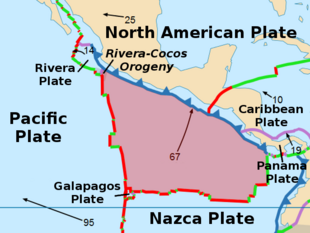Earth:Cocos Plate
| Cocos Plate | |
|---|---|
 | |
| Type | Minor |
| Approximate area | 2,900,000 km2[1] |
| Movement1 | north-east |
| Speed1 | 67 mm/year |
| Features | Cocos Island, Pacific Ocean |
| 1Relative to the African Plate | |
The Cocos Plate is a young oceanic tectonic plate beneath the Pacific Ocean off the west coast of Central America, named for Cocos Island, which rides upon it. The Cocos Plate was created approximately 23 million years ago when the Farallon Plate broke into two pieces, which also created the Nazca Plate. The Cocos Plate also broke into two pieces, creating the small Rivera Plate.[2] The Cocos Plate is bounded by several different plates. To the northeast it is bounded by the North American Plate and the Caribbean Plate. To the west it is bounded by the Pacific Plate and to the south by the Nazca Plate.
The only land above water on the Cocos Plate is Cocos Island, which is administered by Costa Rica and lies approximately 550 km (342 mi; 297 nmi) southwest of the Costa Rican mainland.
Geology
The Cocos Plate was created by sea floor spreading along the East Pacific Rise and the Cocos Ridge, specifically in a complicated area geologists call the Cocos-Nazca spreading system. From the rise the plate is pushed eastward and pushed or dragged (perhaps both) under the less dense Caribbean Plate, in the process called subduction. The subducted leading edge heats up and adds its water to the mantle above it. In the mantle layer called the asthenosphere, mantle rock melts to make magma, trapping superheated water under great pressure. As a result, to the northeast of the subducting edge lies the continuous arc of volcanos —also known as the Central America Volcanic Arc— stretching from Costa Rica to Guatemala, and a belt of earthquakes that extends farther north, into Mexico.
The northern boundary of the Cocos Plate is the Middle America Trench. The eastern boundary is a transform fault, the Panama Fracture Zone. The southern boundary is a mid-oceanic ridge, the Galapagos Rise.[3] The western boundary is another mid-ocean ridge, the East Pacific Rise.
A hotspot under the Galapagos Islands lies along the Galapagos Rise. (see Galapagos hotspot and Galapagos Microplate)
The Rivera Plate north of the Cocos Plate is thought to have separated from the Cocos Plate 5–10 million years ago. The boundary between the two plates appears to lack a definite transform fault, yet they are regarded as distinct. After its separation from the Cocos Plate, the Rivera Plate started acting as an independent microplate.[2]
The devastating 1985 Mexico City earthquake and the 2017 Chiapas earthquake were results of the subduction of the Cocos Plate beneath the North American Plate. The devastating El Salvador earthquakes in January 2001 and February 2001 were generated by the subduction of this plate beneath the Caribbean Plate.
References
- ↑ "Here are the Sizes of Tectonic or Lithospheric Plates". http://geology.about.com/library/bl/blplate_size_table.htm.
- ↑ 2.0 2.1 Manea, V.C.; Manea, M.; Ferarri, L. (2013). "A geodynamical perspective on the subduction of Cocos and Rivera plates beneath Mexico and Central America". Tectonophysics 609: 56–81. doi:10.1016/j.tecto.2012.12.039. Bibcode: 2013Tectp.609...56M. http://ac.els-cdn.com/S0040195113000231/1-s2.0-S0040195113000231-main.pdf?_tid=c79d5548-2918-11e7-80ea-00000aab0f26&acdnat=1493057386_bf3bdceb8fdea9412e3bc7ae1557b8ea. Retrieved 24 April 2017.[yes|permanent dead link|dead link}}]
- ↑ Paul J. Grim, "Connection of the Panama fracture zone with the Galapagos rift zone, eastern tropical Pacific".
External links
- The volcanic arc
- Martin Meschede and Udo Barckhausen, "Plate tectonic evolution of the Cocos-Nazca plate": reconstructing its geological evolution

